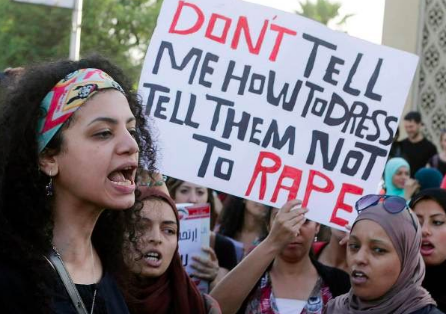|
By: Pauline Francez Gordula On June 13th, Bienvenido “Ben” Tulfo, a Filipino radio personality, released a tweet that chastised Frankie “Kakie” Pangilinan’s stance on how sex crimes should be prevented. On a Rappler article, police from Quezon Province reminded girls on a now-deleted Facebook post to not wear short clothes to avert sex crimes. Pangilinan shot back, calling for people not to rape instead of teaching girls how to dress. In Tulfo’s tweet, he mocked Pangilinan by calling her “hija” and claimed that whenever a rapist or sex offender sees an opportunity to commit their malicious deeds, they will grab it without hesitation. He ended the tweet by warning girls to be more careful with what they wear, or else they are inviting the beast. Being a predominantly Catholic country, the Philippines has ingrained the idea of conservatism for generations. At a young age, girls are instructed to dress modestly to avoid catching unwanted attention from the opposite gender. If someone sees a girl dress scantily, they would label the girl a “slut” or would think that she is asking for “it”. Boys, on the other hand, aren’t taught to refrain themselves. Society has excused their boys’ actions because of the old saying, “Boys will be boys.” The Spaniards, who colonized the country for more than three hundred years, painted an image that a Filipino woman is “meek” and “submissive”. Colonial women are expected to only attend to household chores and maternal duties, making women dependent on men for livelihood. This dependency fueled machismo (an exaggerated sense of masculinity) that will eventually play a role on how men function in society. During the Japanese occupation of the Philippines, Filipino women were used as comfort women by the Japanese army. Between 1942 and 1945, thousands of Filipino women were abducted and raped. 70 years later, these women still struggle to find justice for the cruelty they faced when they were younger. Originally meaning “I’m a young girl”, the #HijaAko movement was launched by Pangilinan, encouraging females to fight for their rights as human beings by sharing their stories of sexual harassment. Thousands of women from all over the Philippines posted about their experience under #HijaAko. Some stories revealed their abusers’ identities while others did not. Through this platform, harassers are being held accountable for the trauma they inflicted upon their victims. In February 2016, Social Weather Stations (SWS) conducted a survey on two barangays in Quezon City regarding street harassment. The survey revealed that 88% of women ages 18 to 24 have experienced sexual harassment at least once. Whenever a woman comes forward to talk about her experience on sexual harassment, people would often ask, “What did you wear?” or would blame her by saying, “It’s because of what you’re wearing!” Women of all ages face harassment, regardless of how skimpy or covered they are. An innocuous child can be a victim, without them knowing that they are enticing older men because of what they wear. An elderly woman, who is fully clothed, can be targeted by teenage boys. Harassment knows no bounds. When I was around nine years old, I was catcalled by a truck driver while waiting for a jeepney with my mother. I looked down to what I was wearing: a pair of khaki shorts. I blamed my clothing for the unwanted trauma I received. From that moment, I vowed to never wear a pair of shorts again every time I would go outside my house. And I didn’t for four years. In retrospect, I wished my mother said something to comfort me, but I understood that like everyone else, she was desensitized to how men in society are. Now at seventeen, I was able to reconcile with my nine-year-old self, reassuring her that her clothes were just fine. Without proper education, boys will continue to believe that women exist for their own pleasure. This mindset would only result in prevalence of women objectification and of sexual harassment. Women are free to wear whatever they want. Clothing, to some women, is art. It’s how we express ourselves. Sometimes, it’s not easy for us to muster the confidence to wear several clothes because we’re afraid to be mocked or criticized. It is not flattering to get catcalled by strangers. We don’t need your input on what we are wearing, nor are we trying to entice anyone. We wear clothes for our own satisfaction. #HijaAko. Bagayas, Samantha. “'Inviting the Beast'? #HijaAko Trends as Women Call out Victim Blaming.” Rappler, 14 June 2020, www.rappler.com/move-ph/263773-hija-ako-trends-women-call-out-victim-blaming.
Don’t tell me how to dress. Digital image. Thomas Reuters Foundation News. 14 June 2014. https://news.trust.org/item/20140614180950-e9to2 “In the Philippines, 'Comfort Women' Who Suffered in WWII Fight to Keep from Being Erased from History.” Https://Www.thelily.com, The Lily, 1 June 2019, www.thelily.com/in-the-philippines-comfort-women-who-suffered-in-wwii-fight-to-keep-from-being-erased-from-history/. Rodriguez, Fritzie. “The Streets That Haunt Filipino Women.” Rappler, 8 Mar. 2016, www.rappler.com/move-ph/124993-sexual-harassment-women-streets. Torralba Titgemeyer, Lorna S. “La Mujer Indigena - The Native Woman.” The Native Woman, 1 Mar. 1997, www.univie.ac.at/ksa/apsis/aufi/wstat/mujer.htm.
0 Comments
Leave a Reply. |



 RSS Feed
RSS Feed
